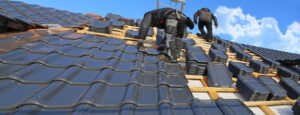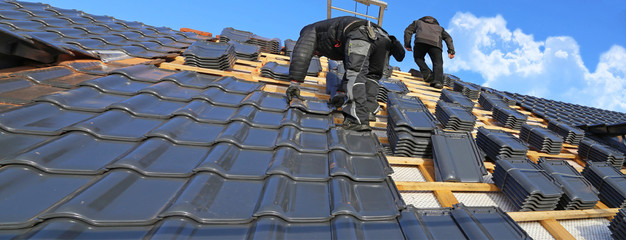Performing regular roofing maintenance can prevent small issues from deteriorating into major problems. Round Rock Roofer also helps prevent costly future repairs.
Visually inspecting your roof will take only a few minutes and can help you spot potential damage before it becomes a serious problem. This should be done at least twice yearly, in the spring and fall.

The soffit is an essential part of the roofline. It helps to keep the attic well ventilated while preventing unwanted pests from entering the house. Performing regular maintenance can help avoid soffit issues, and when they do arise, hiring professional roofers to address them quickly can minimize the damage and minimize any additional costs down the road.
During a heavy rainstorm, wind can cause water to back up under the eaves. Normally, the soffit would stop this from happening, but if it is damaged or has holes, that can cause problems. The fascia board is another important roofing component that should be checked regularly. It is usually installed parallel to the edge of the house and is where rain gutters are attached. Fascia boards protect the house from water damage and can also be a decorative feature.
When inspecting the fascia and soffit, look for signs of insect infestation. If you see gnaw marks, droppings or nesting materials, these are good indicators that animals are infesting the area and that it is time for some repairs. It is best to have a professional check the areas, especially since animals can cause significant damage and create entry points for water or rodents.
Soffit and fascia boards are not something homeowners can easily replace themselves, but if you have a reputable roofer do the work, it will last for many years. Using low-quality soffit or fascia materials can lead to premature deterioration and increased repair costs. It is worth the extra investment to use high-quality materials, especially if you want to minimize the risk of expensive and unnecessary repairs down the road.
Depending on the material used, the fascia board may need to be painted periodically. While it is possible to do this yourself, most homeowners prefer to hire a roofing contractor for these types of projects. They have the expertise to do it right the first time, which will save you time and money in the long run. Choosing the right materials for the soffit and fascia is crucial to prevent moisture damage, as it will be exposed to the elements frequently.
The gutters are the main line of defense for your roof. They drain water away from the foundation and walls, helping prevent mold and mildew, as well as structural damage. Although some people choose to have their homes built without gutters, we strongly recommend having them installed.
Gutters and downspouts need to be cleaned on a regular basis, especially after large storms or if you notice leaves, sticks, or debris blocking them. Clogged gutters allow water to back up under the shingles and cause leaks inside the home. Downspouts that aren’t directing water a few feet away from the house can also lead to rotted or damaged wood, as well as problems with basements and crawl spaces.
During a gutter inspection, make sure the ladder is stable and that you’re wearing appropriate safety gear (long-sleeved shirt and gloves). Start by flushing out the smaller debris with a hose. Next, check the gutters for signs of rust and corrosion. If the gutters are rusting, they may need to be replaced. Also, look for standing water or pools in the gutters. These can be a sign that there’s an inadequate slope or that the hangers and spikes need to be tightened and repositioned.
Finally, examine the splash blocks at the end of each downspout. These devices help direct the water a few feet from the house, but over time they can get knocked down or dislodged. If they’re missing, it’s important to have them repositioned as soon as possible.
Another thing to check is whether the gutters are properly anchored. Over time, the hangers and spikes can loosen or come loose completely, leaving them hanging from the rafters. This can be dangerous and should be fixed right away.
You should also look at the ground landscaping around your home. If bushes or other ground vegetation are growing too close to the house or the roof, you should trim them back a few feet to ensure they won’t interfere during a sudden bad weather event. It’s always a good idea to hire a professional for this type of work.
Trees are a beautiful addition to your property and can add a lot of curb appeal and value. But, when they start growing too close to your roofline and causing damage, it’s important that you keep them trimmed to avoid safety issues and possible roofing problems.
When branches extend over a house, they can cause serious damage and are also a fire hazard. Ideally, they should be kept at least six to ten feet away from the home. If you are not comfortable trimming the limbs yourself, it’s a good idea to hire a professional tree service provider. They have the proper equipment to do this job correctly and safely, reducing the risk of falling debris during storms or damage to your roof.
To ensure your trees are properly trimmed, it is best to follow the guidelines established by an arborist. This will help you to maintain the ideal distance between the tree and your roof, avoiding potential electrical hazards, damage to your roof, and even the possibility of the entire tree falling on your home.
Before you begin cutting any limbs, locate the branch collar. This is the area around the base of the trunk and usually has a slight swelling or rougher bark than the rest of the trunk. You want to be sure you make your cut outside of this area to prevent removing any vital branches that are needed to support the tree.
Next, move to the branch itself and carefully remove it. Make sure you use sharp tools to minimize bark damage and the risk of ripping. Lastly, be careful not to remove too much of the branch, as this can weaken it and expose your roof to damage and leaks.
It is important to check your roof on a regular basis, but it’s equally as important to keep your trees well-maintained. By doing so, you can avoid expensive roof repairs and keep your home safe from potential damages caused by overhanging limbs. Contact a certified arborist to learn more about how far tree branches should be from your roof and how often they should be trimmed.
When a home has an asphalt shingle roof, it is important to inspect the shingles on a regular basis. This should include an initial glance from the ground and, at least once a year, a climb up on the roof. A visual inspection can help identify broken, cracked, or missing shingles. These can then be repaired promptly to prevent water leaks and further damage to the roof and structure of the house.
Shingles can be damaged by hail, heat, rain, and even just age. When a shingle is broken or damaged, it can lead to the failure of other shingles or even the entire roof. The best way to spot these problems is to walk the yard around the house and look for shingles that have fallen off the roof. If the shingles are in a cluster, it could be a sign of a roof leak or other problem that should be investigated.
Another indicator of a problem is if the roof appears to be “buckling” or “curling.” Humidity, age, improper installation of shingles or other materials on the roof, and poor attic ventilation can cause these problems. Curling shingles can crack and break, while buckled shingles may lose adhesion and lift from the roof in high winds.
It is also important to check the flashing on the roof. These are strips of metal (usually aluminum or galvanized metal) that run along the roof at edges and joints. Flashing is necessary to help divert water and to keep water out of tricky areas that shingles cannot cover, such as around skylights, chimneys, walls, roof penetrations, valleys, and other eaves.
A quick and simple test to check the condition of the flashing is to simply pull on it lightly. If the shingle separates from the flashing, it is time to replace it.
In addition to these tests, the inspector should look for other conditions on the roof such as moss, lichen, and plant growth that can damage the shingles. The roof should be cleaned and treated with preventative products to help ensure these growths do not return. Also, the inspector should examine the gutters to make sure they are free of leaves, branches, and other debris that can clog them.

